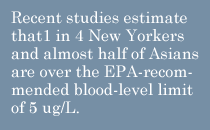What You Should Know About Methylmercury in Fish
Methylmercury (MeHg) is a very potent toxicant that is present in varying amounts in all seafood. Fish is also a very good source of protein and omega-3 fatty acids. The key to enjoying fish and obtaining the health benefits is to know that it is the larger, longer-lived predatory fish like swordfish, shark, and some tuna that contain the most methylmercury. Fish lower on the food chain have less mercury. Knowing which fish are lowest in methylmercury and thus safer to eat can allow one to minimize the risk while still reaping the health benefits of eating seafood.
If You Eat Fish, Choose Wisely
Due to their developing brains, the unborn child and young children are considered
the most vulnerable to MeHg’s toxicity. However, anyone who consumes large amounts
of seafood or regularly eats fish high in mercury can experience negative health effects.
Some health effects that have been seen with high mercury fish consumers include numbness
or tingling around the mouth or in the arms and legs, ataxia or trouble with physical
coordination like walking, cognitive effects such as difficulty thinking clearly,
hair loss, stomach upset, and fatigue. Although all fish have some contamination,
in general, the bigger, longer lived fish such as shark and swordfish and some species
of larger growing tuna such as that used in sushi have the highest levels of mercury.
The amount and frequency of fish consumed, as well as individual susceptibility, probably
due at least in part to genetics, also factor into toxicity.
 There are still many who are unaware that seafood contains potential harmful contaminants.
The EPA-FDA joint advisory on fish targets those considered the most sensitive to
mercury’s toxicity -- women of childbearing age, pregnant and nursing women, and young
children (<6). But avid fish eaters and in particular people who eat higher-mercury
fish may be at risk for overexposure. Data from the National Health and Nutrition
Examination Survey (NHANES) has shown that blood mercury levels in women are higher
among those with higher incomes, among populations that eat more fish (in particular
people of Asian and Pacific Island backgrounds), and among people living in U.S. coastal
regions (Mahaffey et al., 2009).
There are still many who are unaware that seafood contains potential harmful contaminants.
The EPA-FDA joint advisory on fish targets those considered the most sensitive to
mercury’s toxicity -- women of childbearing age, pregnant and nursing women, and young
children (<6). But avid fish eaters and in particular people who eat higher-mercury
fish may be at risk for overexposure. Data from the National Health and Nutrition
Examination Survey (NHANES) has shown that blood mercury levels in women are higher
among those with higher incomes, among populations that eat more fish (in particular
people of Asian and Pacific Island backgrounds), and among people living in U.S. coastal
regions (Mahaffey et al., 2009).
A recent study of blood mercury levels in NYC residents found that almost 50% of Asians and 25% of adults were estimated to be over the EPA reference dose of 5 ug/L.(micrograms per liter) (McKelvey et al, 2007, http://www.nyc.gov/html/doh/html/pr2007/pr059-07.shtml). The EPA reference dose (RfD) was last revised in 2001 and was based on available data at that time (http://www.epa.gov/iris/subst/0073.htm). Subsequent research has shown that pregnant women should keep their blood mercury level below 3.5 ug/L to protect the fetus (Sato, Li & Shaha, 2007). Public health experts consider the RfD of 5 ug/L of mercury in blood to be a level of exposure that is prudent for all other people to use as a guide to safe fish consumption.
We are encouraged by public health organizations and health professionals to eat two meals a week (or about 12 ounces for the average adult; smaller portions are advised for children) of low-mercury fish. Knowing which fish are lower in mercury is the challenge. For information on fish mercury levels and fish consumption advice, please see the Fish Advice page.
References
- Hightower and Moore, “Mercury Levels in High-End Consumers of Fish”, Environmental Health Perspectives, Vol. 111, Number 4, 2003,http://ehp.niehs.nih.gov/members/2003/5837/5837.html
- Mahaffey, K.R., et al., “Adult Women’s Blood Mercury Concentrations Vary Regionally
in the United States: Association with Patterns of Fish Consumption (NHANES 1999-2004)”,Environmental Health Perspectives, 117(1), 2009, http://ehp03.niehs.nih.gov/article/fetchArticle.action?articleURI=info%3Adoi%2F10.1289%2Fehp.11674
- McKelvey, W. et al., “A Biomonitoring Study of Lead, Cadmium, Mercury in the Blood
of New York City Adults”, Environmental Health Perspectives, Vol. 115, Number 10, 2007, http://www.ehponline.net/docs/2007/10056/abstract.html
- Mahaffey et al, “Adult Women's Blood Mercury Concentrations Vary Regionally in the
United States: Association with Patterns of Fish Consumption (NHANES 1999–2004), Environmental Health Perspectives, 2009, http://ehp.niehs.nih.gov/docs/2008/11674/abstract.html
- R.L. Sato, G.G. Li, S. Shaha, "Antepartum seafood consumption and mercury levels in newborn cord blood," American Journal Of Obstetrics And Gynecology 194 (2006) 1683-1688.
